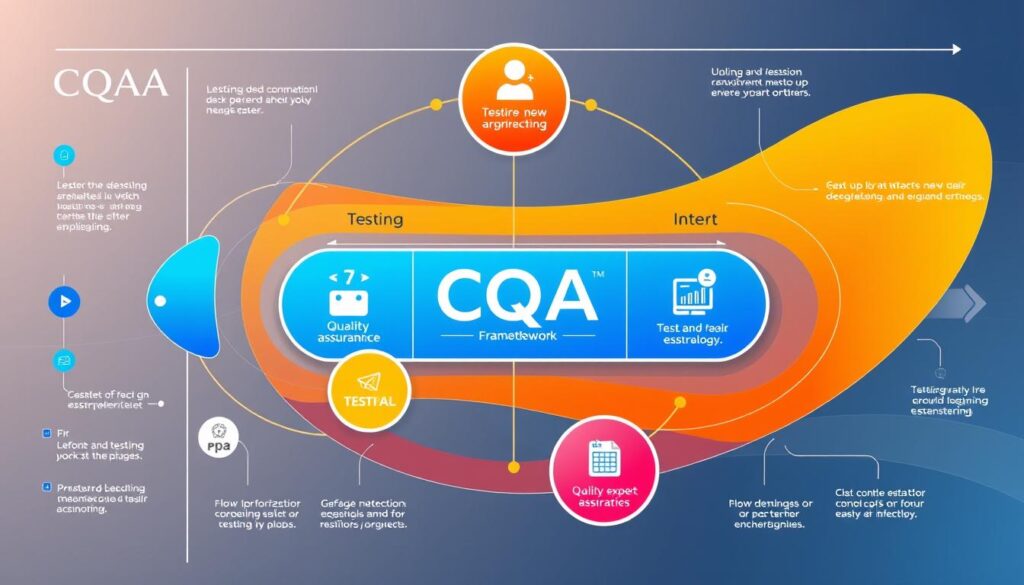In today’s fast-changing mobile world, quality assurance (QA) is key to Android device success. The Convergence Quality Assurance (CQA) test is at the core of this. It checks how well Android phones and tablets work, how they fit together, and how users feel about them.
CQA testing is vital for making Android devices better. It helps makers and developers find and fix problems early. This way, Android devices become more reliable, stable, and easy to use. It means a better experience for customers.
Key Takeaways
- CQA (Convergence Quality Assurance) test is a critical process for ensuring the optimal performance and user satisfaction of Android devices.
- CQA testing evaluates the overall functionality, compatibility, and user experience of Android smartphones and tablets.
- Conducting thorough CQA testing helps Android device makers enhance the reliability, stability, and user-friendliness of their products.
- CQA testing enables manufacturers and developers to identify and address problems before the product hits the market.
- By using effective CQA practices, Android device makers can give customers a top-notch experience.
What is CQA Test?
CQA, or Comprehensive Quality Assurance, is a detailed testing process for Android devices. It checks how well devices work, their performance, and how users feel about them. This process looks at many things, like how well hardware and software work together and how devices use power.
The CQA method is key in making sure Android apps and systems are reliable, easy to use, and safe. It helps ensure these standards are met before devices are available to the public.
Understanding CQA Testing
CQA testing checks how well an Android device works from start to finish. It looks at everything from setting up the device to using apps and features every day. This ensures the device meets top quality and function standards.
It also finds any problems that might affect how users feel about the device. This lets developers fix these issues before they become big problems.
The Role of CQA in Software Quality Assurance
In the fast-changing world of Android development, CQA is very important. It tests the device’s hardware, software, and how users feel about it. This makes sure Android apps and systems are stable, safe, and meet user needs.
This helps make Android devices reliable and popular. They become a top choice for both regular users and businesses.
| CQA Best Practices | CQA Automation | CQA Tools |
|---|---|---|
| Comprehensive testing scenarios | Streamlined testing workflows | Appium, Selenium, Robotium |
| Focus on user experience | Accelerated test execution | AWS Device Farm, Firebase Test Lab |
| Continuous integration and delivery | Reduced manual intervention | Espresso, UI Automator, Monkey |
“The CQA process is essential for ensuring the quality and reliability of Android devices, enabling developers to deliver exceptional user experiences that meet the evolving needs of the market.”
CQA Process and Methodology
Creating top-notch Android devices needs a detailed CQA (Critical Quality Attributes) testing process. This method checks the device’s functionality, performance, security, and how users feel about it. It makes sure the devices live up to the expected standards. Experts use cqa techniques and cqa frameworks to make testing easier and more reliable.
Functional testing is a big part of CQA. It checks if the device’s main features work right. This includes looking at the hardware, software, and all parts together to find and fix problems early.
Performance testing is also key. It checks how well the device works, how stable it is, and how it uses resources. Finding and fixing any slow spots helps make sure users have a smooth experience.
Security testing is another important part. It checks if the device keeps user data safe and guards against threats. This ensures Android devices are secure and safe for users.
User experience testing is the last step. It looks at how easy the device is to use, how it feels, and its design. By testing with users and getting feedback, makers can make the device better for what people want.
| CQA Testing Techniques | Objectives |
|---|---|
| Functional Testing | Verify core device features and capabilities |
| Performance Testing | Evaluate responsiveness, stability, and resource utilization |
| Security Testing | Assess data protection and threat mitigation |
| User Experience Testing | Evaluate usability, ergonomics, and interface design |
By following CQA methods, Android makers can spot and fix problems early. This leads to a better, more reliable product that meets customer needs.

“The CQA process is essential in ensuring the quality, consistency, and compliance of Android devices throughout the manufacturing lifecycle.”
CQA Best Practices for Android Apps
Android app developers aim to give users the best experience. They use cqa automation and cqa tools to make sure their apps work well. This includes checking if the app is functional, performs well, and is easy to use.
Ensuring App Functionality
Testing is key for Android apps. It checks if the app’s main features work right. CQA experts use automated tests to make this faster and cover more ground.
- Validate user interactions and navigation across various screens and scenarios
- Test for error handling and edge cases to mitigate possible problems
- Make sure the app works well with different Android versions and devices
Optimizing User Experience
Improving the app’s user experience is also important. Usability tests help find and fix any issues users might face. This makes the app easier and more enjoyable to use.
- Check if the app’s UI is easy to understand and navigate
- See how fast and smooth the app is, and how happy users are
- Use user feedback to make the app better
By following these CQA best practices, developers can make apps that are reliable, easy to use, and perform well. These apps will attract and keep users, making them stand out in the mobile world.

“Comprehensive quality assurance is the foundation for building exceptional Android apps that users will love.”
Strategies for Effective CQA Testing
Effective CQA testing on Android devices needs a strategic plan. It involves using a risk-based testing method. This method focuses on key functions and high-risk areas to ensure quality and stability.
Also, creating detailed test cases is key. These cases cover many scenarios and use cases. They help find issues and edge cases.
Risk-based Testing Approach
The risk-based testing method focuses on high-risk areas and key functions. This ensures the most important parts of the Android device are checked well. It makes the testing process better by using resources wisely and tackling big concerns first.
Comprehensive Test Case Design
Creating a wide range of test cases is vital for CQA testing on Android. These scenarios cover different user interactions and edge cases. Using proven CQA frameworks helps streamline testing, find and fix issues early, and provide a great user experience.
FAQ
What is CQA test?
CQA (Convergence Quality Assurance) test checks how well Android devices work. It looks at many things like how the device works, how it looks, and how much power it uses. It makes sure the device meets high standards before it’s released.
What is the role of CQA in software quality assurance?
CQA is key in making sure Android apps and systems are reliable and safe. It checks if they work as expected before they’re shared with the public.
What are the key steps in the CQA testing process?
The CQA testing process has several steps. It includes checking if the device works right, how fast it is, and if it’s secure. It also looks at how users feel when using the device. CQA experts use special tools to make testing faster and more accurate.
What are the best practices for CQA testing of Android apps?
To make sure Android apps are top-notch, follow CQA best practices. This means testing the app’s main features and how easy it is to use. Using automation tools helps make testing quicker and more thorough.
What are the key strategies for effective CQA testing?
For effective CQA testing, plan carefully and use a risk-based approach. Designing good test cases is also important. By using proven strategies, manufacturers and developers can make better products and improve user satisfaction.






